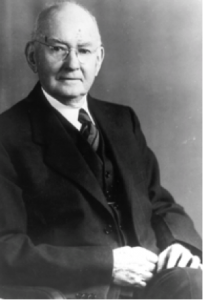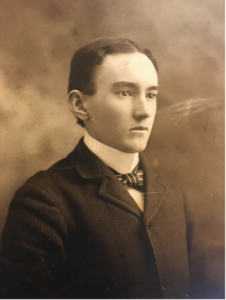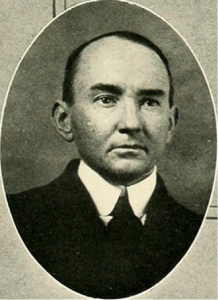Introduction
A musical ring of the bell tower echoes through the North Carolina Collection reading room. Morning sunlight creeps through the windows and falls into lines along the warm walnut tables. It is the fall of 1967 on UNC Chapel Hill’s campus, and the leaves float softly by the window as J. Isaac Cockhon presses record on the tape. He adjusts his seat, clears his throat, and says the date and time. In 1967, Cochkon is the current Director of the Southern Historical Society, and his task on that fall morning was to interview the legendary Dr. Louis Round Wilson on his astonishing career. Dr. Wilson was a renowned researcher and librarian, and whose giant oil portrait hung right beside Mr. Cochkon on the wall. As Wilson answers the interview questions, his voice is soft and full of wisdom, crackling with experience. A voice meant to read stories. A voice belonging to the man that changed the North Carolina Library system into what it is today.
Early Life
Louis Round Wilson was born on December 27, 1876 in the small town of Lenoir in the North Carolina foothills. Fittingly, this was also the same year as the founding of the American Library Association. During his teens he worked in the office of the local newspaper, The Lenoir Topic, as a typesetter and apprentice, and at the local Methodist Church.[2] While at Methodist Church, he had his first experience of librarianship, charging out books to the assorted classes in the Sunday school. He spent a year preparing for college at Davenport (Yale), in New Haven, Connecticut, reciting and studying with J.D. Minnick. He then started his program at Haverford College in 1895 and finished up his studies at University of North Carolina in 1899.[3] Upon his graduation he was awarded the Hume Senior Essayist Medal for his exemplary writings. From there, Wilson taught at private schools across the state until in 1901 he returned as the Librarian of the University of North Carolina. While working as librarian he received his Masters degree in 1902 and his Doctor of Philosophy degree in [field] in 1905. Four years later, while still working at UNC, he married his wife, Penelope Wilson. Together they had three daughters and a son.[4]
Career at UNC
Dr. Wilson began his librarianship career apprehensive, as he was unsure if he wanted to make it his career, or return to his roots in classroom teaching. However, after working with the Library and becoming more familiar with its vital role in the educational system, he realized he had found his life’s passion. From then on, he was determined to make the University of North Carolina Library the best in the country.[6]
In December 1901, Wilson prepared his first annual report on the library for President Francis P. Venable. The report marked a turning point in his career, for although he had only been a librarian for four months, he recommended that the development of an adequate policy for the growth and support of the library was a matter of primary significance. He urged the president that if teaching and research was to be the primary focuses of the university, then a quality library must serve as a sound foundation.[7] Libraries, according to Wilson, were the base of academic teaching, and without the best library, UNC could not be the best school. Professor Henry McGilbert Wagstaff, in his writing in Impressions of Men and Movements of North Carolina, said of Wilson and his belief that,
“A Library, ever increasing its store of the knowledge of the past as well as of the present endeavors of scholars who are making brick for the rising edifice of human enlightenment, seemed to Wilson a prerequisite of an institution of learning.”[8]
Wilson presided over dramatic growth of UNC’s library. When he became university librarian in 1901 there were 38,593 volumes; by the time he left for r Chicago in 1932 there were well over 235,000 volumes. Along with books, he also acquired approximately 47,000 items for the newly formed North Carolina Collection to be used for study and future research. He also planted the seeds in 1904 for the establishment of the Southern Historical Collection, which has become a premier location for investigation into the southern social, economic, and cultural life.[9]
Wilson’s love for librarianship did not end at the library itself, but extended to librarian training, which he first offered in the summer of 1904 and later during the regular school term. In this course, he carefully prepared a series of lectures that fully illustrated library organization and administration, the selection and ordering of books, book accessioning, classification, cataloging, circulation, and other procedures involved in making the information available to the public.[10]
A man with a mission, Wilson worked tirelessly to establish at Library Science school at UNC. He was convinced that a quality library school was vital to properly educate professional librarians in high schools and universities of the south.[11] In the 1967 interview Wilson remembered with pride that, “I started the [library school] here and saw to it that it was properly done and accredited within the first year.”[12] Wilson also founded North Carolina Library Association in 1904 and helped propose the first law for the establishment of the North Carolina Library Commission, which is still active today (in 2017) regulating the state’s library system.[13] According to Wilson, without librarians, there would be a deficit in the quality of education in North Carolina, and that simply would not do.
Extension Work
This quest towards better quality education for North Carolina led Wilson and a small group of UNC faculty to extend library resources to clubs, schools, organizations, and individuals who were seeking information, developing education, or researching projects. In fact, in the 1967 interview Wilson noted that part of his motivation for establishing what became Wilson Library was to, “lend and serve as a resource to women’s clubs and teachers in the local area.” In his Annual Report for 1906-07, Wilson detailed a program for increased extension work, using the current university library as the center of his plan. Through his efforts he established North Carolina’s Bureau of Extension, of which he became director of in 1913. This bureau would serve to allocate the state’s library resources such a pamphlets, books, papers, and other materials to schools and organizations across the state.[15] Wilson also sought out women’s organizations and offered help and services, believing that women deserved the same the benefits of education as men.[16]
Founding of the North Carolina Library Association
Although at times he certainly tried, Wilson soon realized that one librarian could only do so much to promote educational improvement and expansion. This led to Dr. Wilson establishing the North Carolina Library Association in 1904. The formation of this association drastically sped up the development and improvement of libraries in North Carolina. As a member of the association, Wilson promoted traveling libraries, published the North Carolina Library Bulletin, assisted schools, colleges, and communities in the development and improvement of libraries, secured the enactment of library legislation that would facilitate future library development, and collected and published library statistics. [17]
The University of North Carolina Press
Not only did Wilson work in the distribution and extension of books, he also labored to publish them. In 1922, he assisted Dean Edwin Greenlaw in establishing the University of North Carolina Press and was then made the Director. During his decade of service; the UNC press published over 100 titles varying in fields related to southern life and culture.[18]
The Louis Round Wilson Library
In his 1920 annual report to the University President, Wilson pointed out that the university needed a new library to replace the original 1907 library. The old Carnegie Library (now Hill Hall), built in 1906 was no longer able to serve the archival needs of the growing university.[19] However, it was not until 1926 that Dr. Wilson was given the authorization to make his dream into reality.[20] Coincidentally, the university was also planning to build new dormitories and buildings, expanding the campus southward due to its rapidly increasing student body. Dr. Wilson worked with the building planners to make his library the center of what they were calling “the new quad” having it align with the historic South building. [21] In an unsurprising turn of events, Wilson took the lead in designing the building, studying library design and researching features of other prominent modern libraries across the country.
Construction began in 1927 and was completed in 1929. The university held a gala for the new library’s dedication on October 19, 1929, ten days before the onset of the Great Depression on Black Tuesday, Oct. 29, 1929. Although gala attendees donated $146,000 (equivalent of well over 2 million dollars today). For the library, the resulting economic depression caused a strict curtailment of funds for books and library staff. Dr. Wilson’s response to the cut in funds was the founding of the Friends of the Library to financially support the growth of the University Library. Wilson also approached Sarah Graham Kenan, who gifted funds to help fund Wilson’s dream of a collection of documents and manuscripts that all related to the American South, now known as the Southern Historical Collection.[22] Therefore, the the library came out seemingly unscathed in the Great Depression.
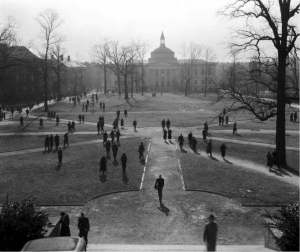
Joe Hewitt. The Louis Round Wilson Library: Celebrating 75 Years of Public Service. Chapel Hill, NC. Wilson Library, 2004. “The Quad in Front of Wilson”.
The building’s architecture is significantly different than the other buildings constructed at the time (Steel Building, Manning, Saunders, and Murphey Halls). While the former buildings erected reflect the consulting architect’s plan for a colonial style Wilson Library was designed in the Classical to show the importance and prominence of the new building. With its grey/white limestone facade and towering columns it stands apart from the red brick buildings of the lower quad. Furthermore, the 85-foot dome of solemn regality looms over the Quad, a stark contrast of the other simpler buildings it neighbors.[24]
Inside, a large foyer leads to two double staircases that convey patrons to the main floor, where a a mystical reading room extends the entire length of the building. The room is well lit, with 28-foot ceilings, stunning windows that face outwards to South Building, and a beautiful chandelier that is suspended from the sky lit dome.[25] Even from the beginning, with its stacks holding 450,000 volumes and 130 carrels and seminar rooms meant for graduate students and faculty, it was clear that this capacity would serve to be insufficient. Therefore, additions onto the south side of the building were planned.
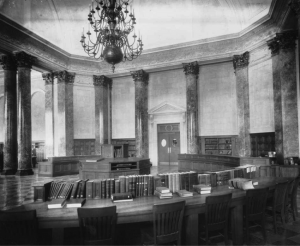
Joe Hewitt. The Louis Round Wilson Library: Celebrating 75 Years of Public Service. “Rotunda of the Reading Room”
After the completion of the addition in 1956, the building, originally simply called, “The Library” was renamed for Wilson. The 1956 addition doubled the stack space and provided a home for the newly created archival collections; the North Carolina Collection, the Southern Historical Collection, and the Rare Book Collection. Through the continuing support of the Friends of the Library, in 1960 the library held one million volumes. By 1984, the library held three million volumes.[27]At the re-dedication in 1987 of the building that coincided with its completion, UNC Professor Alexander Heard speaking to the audience said, “ When the Library was named for Mr. Wilson in 1956 I wrote him that, since the University was already spoken for, the Library would have to do.“ [28] Dr. Heard’s closing statement at the re-dedication almost perfectly summarizes Wilson’s library dreams.
“ In a true university the first concern is the human intellect, but the main concern is the human being. The scrambled, heterogeneous records of human beings embraced in manuscripts and archives, in folklore, in literary creativity, in reports of human adventure, in all these special collections gathered here in Chapel Hill, give a crucial resource and an authentic hope for the uses of sensitivity and intelligence and principle in creating a more rewarding and nobler future for all who are touched by the spreading influence of this, your, great university of the people.” [29]
After the construction of Davis library (the new central library) in April of 1985 Wilson Library was converted into a Special Collections Library. This revamping lead to the creation of the Manuscripts department, the Maps Collection, The North Carolina Collection, and the Rare Book Collection. Dr. Wilson would certainly have been pleased with this development, seeing as how this center of archival research was his original vision for the building. [30]
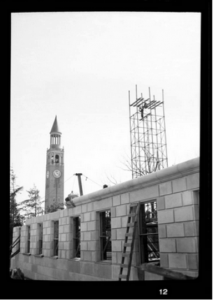
Samuel Moyle Boone Photographic Collection, circa late 1940s-early 1960s. Wilson Library: Construction of addition, 10 March 1950
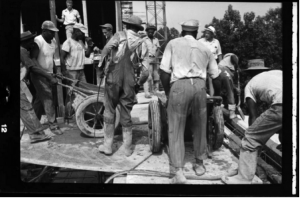
Samuel Moyle Boone Photographic Collection, circa late 1940s-early 1960s. Wilson Library: Construction of addition, 10 March 1950
Contributions to Librarianship (Chicago and Abroad)
In 1926, the University of Chicago invited Wilson to become the dean of their graduate school. However, he initially refused. Wilson later remembered, “I had the ambition to see that this building was planned and completed.” [33] By 1932, he was ready to accept Chicago’s offer and became the dean of the Graduate Library School. Under Wilson’s direction, that school soon became the nation’s leading center for graduate training and research in librarianship. Wilson pioneered the development of librarianship into a field of scientific study and research. Additionally, Wilson pushed for a publication program, which contributed further the development of a philosophy of librarianship.[34]
Wilson also served as a library surveyor (a type of mentor ship wherein he helped to guide the librarians of the college and made recommendations for improvement) for Davidson College, Guildford College, Columbia Seminary in Decatur, Georgia, the Vanderbil- Peabody-Scarrit Group, Alabama Polytechnic Institute, Tuskegee Institute, Grosvenor and Buffalo Public Libraries, New York State Library, Louisiana State University, and the Universities Georgia, Florida, South Carolina, Sanford, Denver, Atlanta, Cornell, and Notre Dame. Through these surveys he made recommendations for the libraries to improve and inspired faculties to take up the librarianship cause. [35]
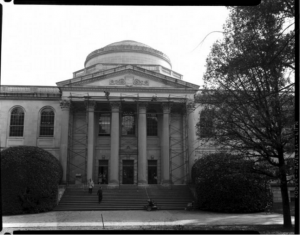
Samuel Moyle Boone Photographic Collection, circa late 1940s-early 1960s. Wilson Library: Exterior views: “Carving name of L. R. Wilson Library in stone,” 28 November 1956
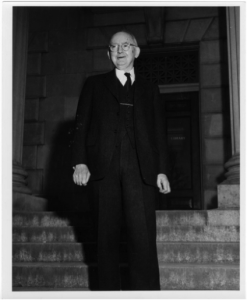
Louis Round Wilson photographic collection, circa 1860s-1980s. Wilson on the steps of the newly named Louis Round Wilson Library. On the back is written, “ Picture taken to celebrate the UNC library being named the Louis Round Wilson Library. March 1956.”
Conclusion
In an 1932 article in The Library Quarterly, “Aspects of Education for Librarianship in America”, Wilson described his life’s mission: that in improving the libraries of the educational system, he would be improving the future of the people of the South.[38],[39] Over is 77-year career; Wilson published almost 300 works regarding librarianship and libraries. His contribution to librarianship in the United States and North Carolina is not quantifiable, but because of his influence the profession evolved into a center of academic study. And yet, when asked in the 1967 interview what advice he would give students of UNC, Wilson downplayed his accomplishments, saying with a laugh, “You win about a third of the things you want to do.” Over his life Dr. Wilson received honorary doctorates given by Haverford, North Carolina, Denver, and Catawba, was inducted as an honorary life member of the American Library Association, presented the Herbert Putnam Award for outstanding Librarianship, along with many more honors.[40] He worked tirelessly throughout his life, working every minute for the benefit of others. He accomplished more than most of us could hope to achieve, and that was him winning a third of what he wanted.
-Written by Jordan Hennessee for Professor Anne Whisnant’s HIST 671 Fall 2017 Class-
Bibliography:
- Bullock, James Marshall. Louis Round Wilson and the Planning of an Academic Library at the University of North Carolina, 1921-1929.
- Heard, Alexander. Remarks at the Rededication of the Louis Round Wilson Library. Chapel Hill, N.C.: Friends of the Library and University Library, University of North Carolina at Chapel Hill, 1990. Print. Pg 2.
- Martin, Robert Sidney. Louis Round Wilson at the University of North Carolina, 1901-1932. Thesis. 1988. Pg. 381.
- Louis Round Wilson photographic collection, circa 1860s-1980s (Photos stored on Camera in Order Below. Young Wilson (circa 1890)- Sepia colored portrait of profile, wearing suit and bowtie
- Louis Round Wilson photographic collection, circa 1860s-1980s. Wilson on the steps of the newly named Louis Round Wilson Library. On the back is written, “ Picture taken to celebrate the UNC library being name the Louis Round Wilson Library. March 1956.”
- Samuel Moyle Boone Photographic Collection, circa late 1940s-early 1960s. Wilson Library: Exterior views: “Carving name of L. R. Wilson Library in stone,” 28 November 1956
- Tauber, Maurice F. The Contributions of Louis Round Wilson to Librarianship. New York: H.W. Wilson, 1956. Print.
- Cockhon, Isaac. Louis R. Wilson Interview. Southern Historical Collection. 1967.
- Tauber, Maurice. Louis R. Wilson- A Biographical Sketch. Chapel Hill, NC: North Carolina Friends of the Library, 1956.
- University of North Carolina at Chapel Hill. Library. Louis Round Wilson Library. Chapel Hill, N.C.: University Library, University of North Carolina at Chapel Hill, 1997. Print.
- “Wilson Library Fall 2016” Author Unknown. http://blogs.lib.unc.edu/news/wp-content/uploads/2015/03/wilson_fall_scenes_750.jpg.
- Wilson, Louis Round. Aspects of Education for Librarianship. The Library Quarterly. 1932. Pg.1.
- Featured Image: Haefele, Chad. “Intranet Logo”. https://libux.web.unc.edu/2016/05/21/building-an-intranet-navigation-structure/.
Further Reading:
1. Louis Round Wilson Photographic Collection, circa 1860s-1980s:
http://finding-aids.lib.unc.edu/P0040/
2. Louis Round Wilson Papers, 1833-1985:
http://finding-aids.lib.unc.edu/03274/
3. Librarians’ Association at the University of North Carolina at Chapel Hill Records, 1972-2003: http://finding-aids.lib.unc.edu/40204/
4. Names in Brick and Stone: Louis Round Wilson Library: https://unchistory.web.unc.edu/building-narratives/louis-round-wilson-library/
Footnotes:
[1] Maurice F. Tauber. Louis R. Wilson- A Biographical Sketch. Chapel Hill, NC: North Carolina Friends of the Library, 1956. pg 5.
[2] Maurice F. Tauber. Louis R. Wilson- A Biographical Sketch. Pg 7.
[3] Maurice F. Tauber. Louis R. Wilson- A Biographical Sketch. pg 8.
[4] Maurice F. Tauber. Louis R. Wilson- A Biographical Sketch. pg. 8
[5] Louis Round Wilson photographic collection, circa 1860s-1980s, Young Wilson (circa 1890)- Sepia colored portrait of profile, wearing suit and bowtie/
[6] Maurice F. Tauber. Louis R. Wilson- A Biographical Sketch. Pg. 9.
[7] Maurice F. Tauber. The Contributions of Louis Round Wilson to Librarianship. New York: H.W. Wilson, 1956. Print. Pg. 315.
[8] Maurice F. Tauber. Louis R. Wilson- A Biographical Sketch. Pg. 9.
[9] Maurice F. Tauber. Louis R. Wilson- A Biographical Sketch. Pg. 9.
[10] Maurice F. Tauber,. The Contributions of Louis Round Wilson to Librarianship. Pg 316.
[11] Maurice F. Tauber. The Contributions of Louis Round Wilson to Librarianship. Pg 316.
[12] Isaac Cockhon. Louis R. Wilson Interview. Southern Historical Collection. 1967.
[13] Robert Sidney Martin. Louis Round Wilson at the University of North Carolina, 1901-1932. Thesis. 1988. Pg. 381.
[14] Louis Round Wilson photographic collection, circa 1860s-1980s.
[15] Maurice F. Tauber. Louis R. Wilson- A Biographical Sketch. Pg. 11.
[16] Isaac Cockhon. Louis R. Wilson Interview. Southern Historical Collection. 1967.
[17] Maurice F. Tauber. Louis R. Wilson- A Biographical Sketch. Pg. 12.
[18] Robert Sidney Martin. Louis Round Wilson at the University of North Carolina, 1901-1932.pg. 335.
[19] University of North Carolina at Chapel Hill. Library. Louis Round Wilson Library. Chapel Hill, N.C.: University Library, University of North Carolina at Chapel Hill, 1997. Print.
[20] James Marshall Bullock. Louis Round Wilson and the Planning of an Academic Library at the University of North Carolina, 1921-1929. Pg. 12.
[21] James Marshall Bullock. Louis Round Wilson and the Planning of an Academic Library at the University of North Carolina, 1921-1929. Pg. 13.
[22] Alexander Heard. Remarks at the Rededication of the Louis Round Wilson Library. Chapel Hill, N.C.: Friends of the Library and University Library, University of North Carolina at Chapel Hill, 1990. Print. Pg 2.
[23] Joe Hewitt. The Louis Round Wilson Library: Celebrating 75 Years of Public Service. Chapel Hill, NC. Wilson Library, 2004. “The Quad in Front of Wilson”.
[24] James Marshall Bullock. Louis Round Wilson and the Planning of an Academic Library at the University of North Carolina, 1921-1929. Pg. 13.
[25] James Marshall Bullock. Louis Round Wilson and the Planning of an Academic Library at the University of North Carolina, 1921-1929. Pg. 14.
[26] Joe Hewitt. The Louis Round Wilson Library: Celebrating 75 Years of Public Service. “Rotunda of the Reading Room”
[27] University of North Carolina at Chapel Hill. Library. Louis Round Wilson Library. Pg 3.
[28] Alexander Heard. Remarks at the Rededication of the Louis Round Wilson Library. Pg 1.
[29] Alexander Heard. Remarks at the Rededication of the Louis Round Wilson Library.Pg 11.
[30] University of North Carolina at Chapel Hill. Library. Louis Round Wilson Library. Pg 4.
[31] “Wilson Library Fall 2016” Author Unknown. http://blogs.lib.unc.edu/news/wp-content/uploads/2015/03/wilson_fall_scenes_750.jpg.
[32] Samuel Moyle Boone Photographic Collection, circa late 1940s-early 1960s. Wilson Library: Construction of addition, 10 March 1950
[33] Isaac Cockhon. Louis R. Wilson Interview. Southern Historical Collection. 1967
[34] Maurice F. Tauber. The Contributions of Louis Round Wilson to Librarianship.pg. 320.
[35] Maurice F. Tauber. The Contributions of Louis Round Wilson to Librarianship.pg. 322.
[36] Samuel Moyle Boone Photographic Collection, circa late 1940s-early 1960s. Wilson Library: Exterior views: “Carving name of L. R. Wilson Library in stone,” 28 November 1956
[37] Louis Round Wilson photographic collection, circa 1860s-1980s. Wilson on the steps of the newly named Louis Round Wilson Library. On the back is written, “ Picture taken to celebrate the UNC library being name the Louis Round Wilson Library. March 1956.”
[38] Louis Round Wilson papers, 1833-1985.
[39] Louis Round Wilson. Aspects of Education for Librarianship. The Library Quarterly. 1932. Pg.1.
[40] Maurice F. Tauber. The Contributions of Louis Round Wilson to Librarianship.pg. 322.

